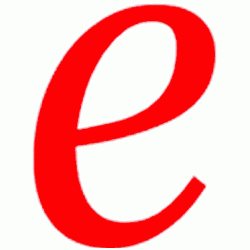We’re marking World Water Week, a gathering in Sweden intended to solve water-related challenges such as droughts, floods and food security. Let’s invest in it.
Source link
Tag: gold
-

Decoder Replay: Gold is valuable. But you can’t drink it.
-
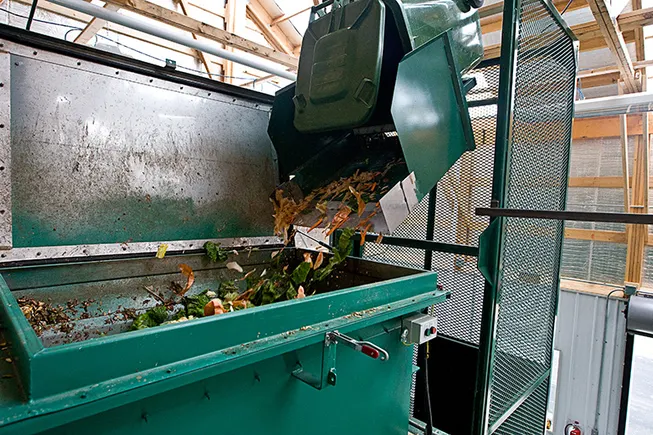
College composting program turns cafeteria scraps to brown gold
This audio is auto-generated. Please let us know if you have feedback.Ohio University processes more than five tons of food waste every day, turning the scraps left over from hungry college students at the institution’s cafeterias into “brown gold” — compost that the university uses to fertilize plants around the campus and sell to neighbors.
In most dining halls, any leftover food is placed on a conveyor belt where an employee from the university’s Culinary Services department separates the contents into food waste, landfill waste and recyclable waste. This collection process allows the University to compost nearly 100% of food waste from campus dining halls and its central food facility, the university said April 17 in a blog post.
“Basically, it’s completely circular in that we take that food waste out of the earth, we process it, we make a soil amendment and then we return it to our grounds,” Sam Crowl, director of sustainability at Ohio University, told Facilities Dive.
Compost bins are collected, five days a week, and taken to the OHIO facility, which is co-managed by the university’s facilities management team and the Office of Sustainability. The facility contains two-ton and four-ton in-vessel systems that help to ensure the recycling process is effective by churning out quality soil while also limiting any chance of methane-producing bacteria, Ohio University says.
After adding in wood chips to create a chemically-balanced mixture, the compost is turned and heated to further the decomposition process. “We have a chipper so we’re able to produce some of our own wood chips, but we also have to purchase [some]. So that’s an expense,” Crowl said.
After two weeks in the vessel, the material is taken outside to be cured in long outdoor piles, or windrows, for 90 to 180 days, that are turned by tractor.
“The vast majority of the product that the system produces is returned to our campus grounds. It goes into our landscape beds. It is used anywhere we want to provide nutrients, so we put it around our trees,” Crowl said. In addition, the compost is provided to community gardens through partnerships with local schools and other departments on campuses.
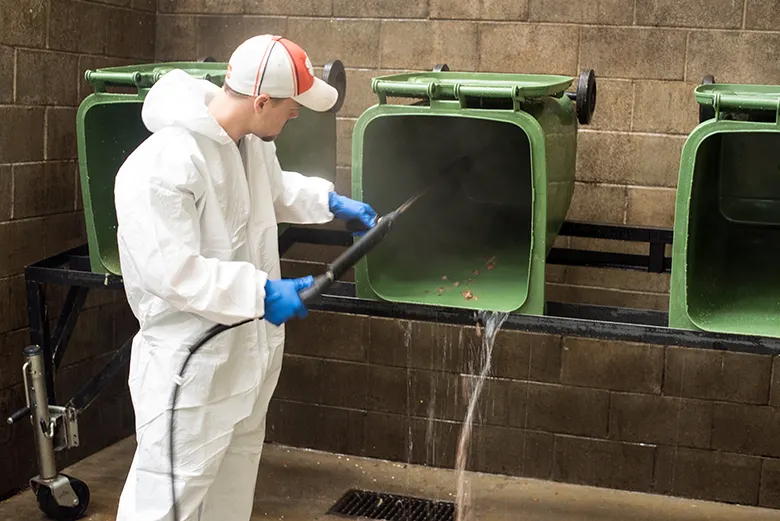
An Ohio University employee powerwashes compost bins. The bins are set up on a rack and power washed with water from a rainwater collection system so that they can be reused.
Retrieved from Ohio University on May 06, 2025“So it’s available internally to university partners, and then also it’s available externally. We do have a process where community members or small local farmers can purchase the product,” Crowl said. “We don’t really do a lot of marketing or advertising of that, so it’s not a huge part of our economics, or how we support the system. But it is available, and it is sold locally.”
Once compost bins are dropped off at the OHIO facility, which features a specialized solar-thermal system, waste oil burner and plastic skylights for heating the building, the bins are set up on a rack and power washed with water from a rainwater collection system so that they can be reused.
The problem with kids — and teachers — these days
The compost bins can also be found at the university’s central food facility in Athens, Ohio, as well as various offices and even some resident halls via an opt-in program. While the system has been operating pretty seamlessly since it began in 2009, the university did run into a challenge when attempting to expand the system to include waste from its student union’s food court: the public.
Compost facilities in Ohio are rate limited by the Ohio Environmental Protection Agency, which examines the facility once a year to check ground water and make sure that no leaks are contaminating the ground water supply or nearby streams.
“Our biggest challenge has been contamination of the water stream,” Crowl said. Despite many attempts over a year and a half to improve signage at the public food court, properly separating food waste from landfill waste and recyclable waste “was something that the public just couldn’t really handle,” he said.
After running an internal audit and examining the situation, Crowl realized that it wasn’t just students failing to separate garbage from food waste, “it was pretty much everybody. Not everybody, but a wide spectrum of different people who were incorrectly putting items in the wrong place.”
While the university’s cafeterias have employees for separating materials, it doesn’t have the staff to go through each bin to make sure they are completely clean of non-food waste. “There was so much contamination coming out of the student union that they couldn’t get it all, and the Ohio EPA came up for their annual inspection and there were potato chip bags, or plastic lids and utensils, in the compost,” according to Crowl.
“They said, ‘Look, you have to clean this up or we are not going to be able to give you your permit this year.’ It was a small fraction of the overall sort, but I can understand their concerns,” he said. “And so the only way, after we tried different signage and instructions, we could really solve that problem was by not having a compost collection effort at the student union.”
Now that the university stopped collecting from the union, it no longer has any more problems keeping compost clean, Crowl said.
-

From the ground in Kenya to the gold stud in the ear
Artisanal gold mining in Kenya’s Western region is raising environmental and public health concerns as mercury contamination threatens both the miners and local water sources.
At sunrise in western Kenya’s Migori County, small groups of men and women gather at makeshift gold pits, sifting through soil in search of a precious livelihood. Across Kenya’s western counties, tens of thousands of people have turned to artisanal gold mining — small-scale, informal mining operations, often characterized by manual labor and the use of basic tools and low-tech equipment — as global gold prices rise and traditional farming incomes decline.
But while mining offers a vital economic lifeline, it brings a toxic legacy: mercury contamination that threatens health, water and livelihoods far beyond the mines.
A growing Industry in Western Kenya, small-scale gold mining has expanded rapidly in counties such as Migori, Kakamega and Vihiga. Recent estimates suggest that Kenya is home to more than 250,000 artisanal miners, with more than one million people depending on gold-mining for their livelihoods. In Migori alone, gold mining injects an estimated US$37 million into the local economy each year.
Despite the dangers, mining remains the most viable source of income for many. Surveys in Migori found that a significant majority of miners would not leave the industry, citing a lack of alternatives.
Extracting gold
Women make up an estimated 38% of Kenya’s small-scale gold mining workforce, often involved in ore processing — where mercury exposure is highest — yet receive just 11% of the sector’s revenue.
Nashon Adero, a lecturer at Taita Taveta University and a Kenyan mining policy expert, said that women’s roles and vulnerabilities are often overlooked in policy discussions.
Herman Gibb, a lecturer at George Washington University and managing partner and president of Gibb & O’Leary Epidemiology Consulting said that mercury is widely used by artisanal miners because it is cheap, accessible and effective at extracting gold from ore.
“It’s the easiest way for miners with limited resources to extract gold,” said Gibb, who used to work for the U.S. Environmental Protection Agency.
The process, known as amalgamation, involves mixing crushed ore with liquid mercury. Mercury binds to gold, creating an amalgam, which is then heated to vaporize and remove the mercury, leaving behind pure gold. But Gibb said that this heating releases toxic mercury vapour, endangering miners and nearby communities.
Mercury poisons
Researchers, including Gibb, have warned that mercury vapour can settle in households, exposing families, particularly children and pregnant women. Biomonitoring studies, including hair sampling, have shown high levels of exposure among women in small-scale gold mining regions.
However, research shows that testing capacity in rural Kenya is limited, and the logistics of sampling, storage and analysis pose additional barriers to effective surveillance. Mercury poses a variety of risks, depending on the form of exposure and who is exposed.
Elemental mercury, the liquid form used in gold extraction, poses serious risks when inhaled as vapour, which can cause neurological symptoms such as tremors, memory loss and cognitive impairment. Prolonged exposure can also cause kidney damage.
“Mercury vapour can damage the brain, especially in children whose nervous systems are still developing,” Gibb said.
Methylmercury, on the other hand, is an organic form of mercury created when elemental mercury enters water bodies and undergoes microbial transformation. It accumulates in fish and other aquatic organisms, entering the food chain. Methylmercury is particularly harmful to pregnant women and children, as exposure can lead to severe developmental disorders, intellectual disabilities and long-term neurological damage.
Chemicals in the food stream
Gibb said that when methylmercury enters the food chain, the risks become even more serious. “This is a toxin that affects the most vulnerable in invisible but lasting ways,” he said.
Although Kenya’s Mining Act of 2016 bans mercury use in mining, enforcement remains weak, and mercury is still widely available in local markets. News reports from the Kenya Chamber of Mines, the main mining industry organization in Kenya, state that many miners lack awareness of its dangers or access to protective equipment.
A 2023 study found that groundwater within six kilometers of mine sites in Migori contained mercury levels exceeding Kenya’s safe drinking water limit of 0.001 mg/L during the dry season. Soil samples from mine tailings (waste materials left over after valuable minerals have been extracted) showed mercury concentrations above 9.6 mg/kg, surpassing the National Environment Management Authority discharge limits.
Kenya’s mercury crisis is part of a wider global problem. Gibb said that the World Health Organization estimates prenatal exposure to methylmercury causes more than 227,000 new cases of intellectual disability each year, contributing to nearly two million “disability-adjusted life years” — a measure of years lost to ill-health or disability.
Mercury ranks among the top chemical threats to global health. Gibb said that its burden is compounded by the fact that most harm is invisible and long-term, making it difficult to prioritize in health budgets.
Science diplomacy
In 2017, Kenya ratified the Minamata Convention, an international treaty designed to protect human health and the environment from releases of mercury, committing to reduce mercury use and emissions. Yet implementation lags. A 2022 Auditor General’s report found that the Ministry of Petroleum and Mining had not mapped or formally designated artisanal mining zones in key counties.
Adero, the Kenyan mining expert emphasized the need for “science diplomacy” — the use of geospatial technologies (mapping tools and location data) and data-driven reports to influence local and national policymakers. Recent GIS-based research (Geographic Information System, or mapping software that shows roads, rivers, houses etc.) show mercury levels remain high in soil and water near mines.
“This highlights enforcement gaps and spatial risks [risks due to location] that many policymakers overlook,” he said.
Monitoring mercury exposure in rural areas is especially challenging due to limited laboratory facilities, transportation and technical capacity.
“We cannot manage what we do not measure,” Adero said. “Without proper exposure tracking, policies are just words on paper. We need data that is local, current and trusted by both governments and communities.”
Enforcing regulations
Gibb said that constraints around sample collection, storage and analysis hinder the ability to track exposure and enforce regulations.
The Migori county government has signed an agreement with the State Department for Environment and Climate Change to establish demonstration sites for mercury-free processing. But while these techniques can be effective, Gibb said, they require up-front investment, training and new equipment and that some alternatives such as cyanide also pose environmental risks.
Adero said that early adoption in countries such as Tanzania and Ghana shows promise but similar scale-up in Kenya remains limited.
Gender and social dimensions organizations such as the Association of Women in Energy and Extractives in Kenya address gender disparities by organizing cooperatives, providing training and advocating for gender-sensitive safety policies.
In his research, Adero found that significant gender gaps remain, with women overrepresented in the most dangerous roles but undercompensated. This research underscores that these disparities are rooted in systemic deprivation and limited access to education and financial literacy, he said.
Bureaucracy and fees
While formalizing small-scale gold mining through Kenya’s Mining Act of 2016 could improve safety and access to technical assistance, progress is slow, hindered by bureaucracy and high fees. Adero advocates simplifying the permitting processes, reducing costs and exempting small-scale miners from fees — learning from successful models such as Ghana’s community mining schemes.
Yet until real changes happen on the ground, artisanal miners remain caught between economic necessity and the invisible dangers of mercury poisoning.
“It’s what we know, and it works — you can see the gold right away,” said a miner from Migori.
But Dr. Adero warns that real progress requires concrete actions, not just policy declarations. Reliable, on-the-ground data to measure mercury exposure and inform decisions is key.
As Kenyan miners struggle with mercury poisoning, consumers around the world unknowingly wear and invest in gold that carries hidden human and environmental costs. Ultimately, addressing mercury contamination is not just a local challenge, it’s a call to action for global accountability, connecting distant luxury markets directly to the miners who risk their health and lives for precious metals.
Questions to consider:
1. Why do some people in Kenya risk their health to mine for gold?
2. What are some things the Kenyan government is doing to improve the lives of gold miners?
3. Why do you think gold is considered so valuable?
-
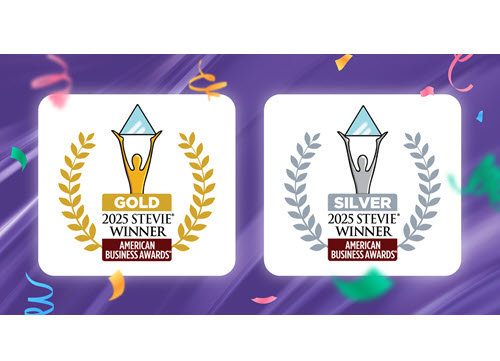
Otus Wins Gold Stevie® Award for Customer Service Department of the Year
CHICAGO, IL (GLOBE NEWSWIRE) — Otus, a leading provider of K-12 student data and assessment solutions, has been awarded a prestigious Gold Stevie® Award in the category of Customer Service Department of the Year at the 2025 American Business Awards®. This recognition celebrates the company’s unwavering commitment to supporting educators, students, and families through exceptional service and innovation.
In addition to the Gold award, Otus also earned two Silver Stevie® Awards: one for Company of the Year – Computer Software – Medium Size, and another honoring Co-founder and President Chris Hull as Technology Executive of the Year.
“It is an incredible honor to be recognized, but the real win is knowing our work is making a difference for educators and students,” said Hull. “As a former teacher, I know how difficult it can be to juggle everything that is asked of you. At Otus, we focus on building tools that save time, surface meaningful insights, and make student data easier to use—so teachers can focus on what matters most: helping kids grow.”
The American Business Awards®, now in their 23rd year, are the premier business awards program in the United States, honoring outstanding performances in the workplace across a wide range of industries. The competition receives more than 12,000 nominations every year. Judges selected Otus for its outstanding 98.7% customer satisfaction with chat interactions, and exceptional 89% gross retention in 2024. They also praised the company’s unique blend of technology and human touch, noting its strong focus on educator-led support, onboarding, data-driven product evolution, and professional development.
“We believe great support starts with understanding the realities educators face every day. Our Client Success team is largely made up of former teachers and school leaders, so we speak the same language. Whether it’s during onboarding, training, or day-to-day communication, we’re here to help districts feel confident and supported. This recognition is a reflection of how seriously we take that responsibility and energizes us to keep raising the bar,” said Phil Collins, Ed.D., Chief Customer Officer at Otus.
Otus continues to make significant strides in simplifying teaching and learning by offering a unified platform that integrates assessment, data, and instruction—all in one place. Otus has supported over 1 million students nationwide by helping educators make data-informed decisions, monitor progress, and personalize learning. These honors reflect the company’s growth, innovation, and steadfast commitment to helping school communities succeed.
About Otus
Otus, an award-winning edtech company, empowers educators to maximize student performance with a comprehensive K-12 assessment, data, and insights solution. Committed to student achievement and educational equity, Otus combines student data with powerful tools that provide educators, administrators, and families with the insights they need to make a difference. Built by teachers for teachers, Otus creates efficiencies in data management, assessment, and progress monitoring to help educators focus on what matters most—student success. Today, Otus partners with school districts nationwide to create informed, data-driven learning environments. Learn more at Otus.com.
Stay connected with Otus on LinkedIn, Facebook, X, and Instagram.
Latest posts by eSchool News Staff (see all) -
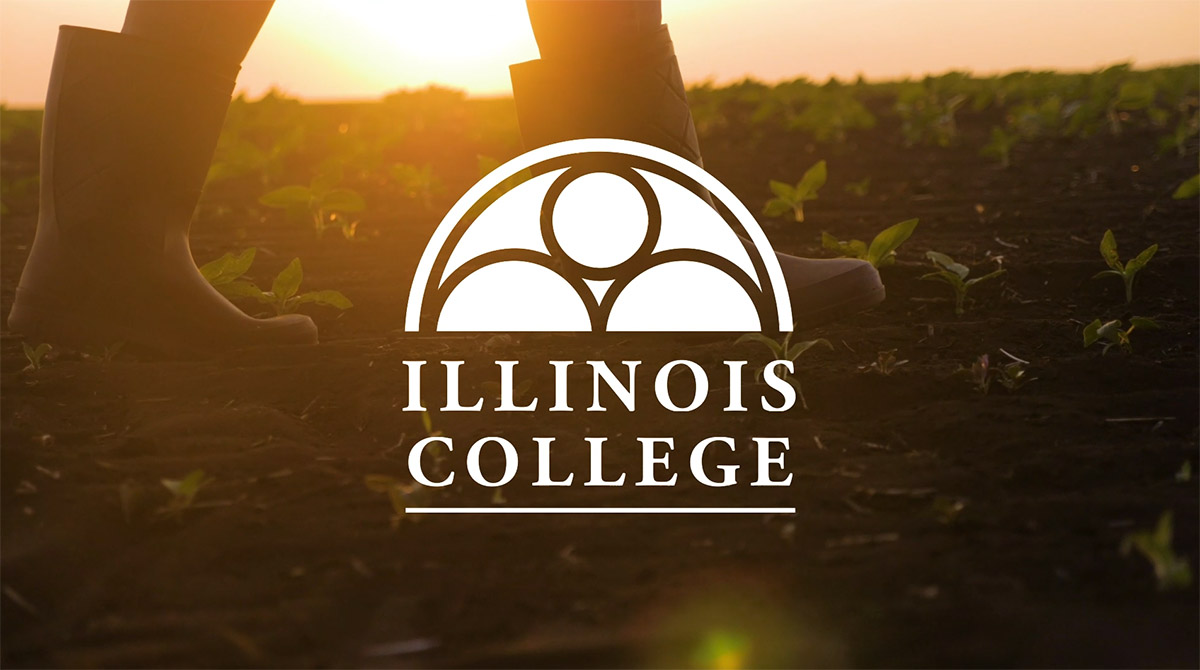
Setting the Gold Standard for College Recruitment Campaigns
Marketing messages bombard students from every direction, so capturing their attention—and inspiring them to take action—requires creative that truly stands out. That’s exactly what the RNL creative team delivers, crafting award-winning campaigns that engage, resonate, and drive results across every channel, from digital to direct mail. We work closely with our campus partners to ensure every undergraduate and graduate campaign is both strategic and impactful—proven by the many gold award-winning projects we’re celebrating this year.Here are 11 that took home gold medals—and one Best of Show—at the 40th annual Educational Advertising Awards.
Illinois College Agribusiness Management |SEO Video (Best of Show)
Video isn’t just eye-catching—it’s a powerful SEO booster that keeps visitors on the page longer to improve search rankings. For this project, we paired SEO-optimized web copy with a compelling long-form video designed to engage skimmers and drive inquiries. Illinois College’s campus team fully embraced the collaboration, delivering stunning unique footage that brought their story to life. The result? A versatile, high-impact asset that drove a 7,000% increase in web page visits. Watch the video.
University of Tulsa | Standout Integrated Search Campaign
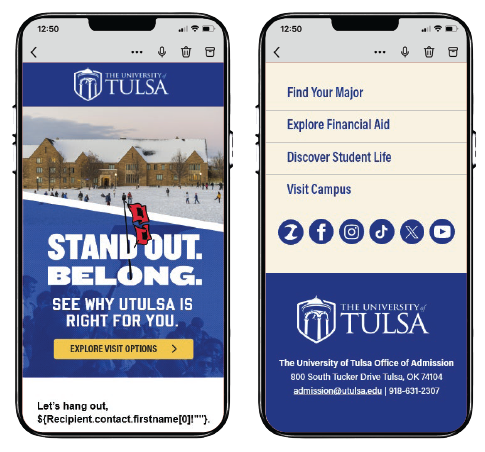
Reaching high school sophomores and juniors means meeting them where they are—in their inboxes, on their feeds, and in their hands. This multi-channel campaign reinforces the University of Tulsa’s bold message: students don’t have to choose between fitting in and standing out. Rich Art Deco design and conversational copy celebrating personal and academic uniqueness helped elevate brand nationwide while encouraging students to find their fit at UTulsa.
Linfield University | Personalized Applicant Direct Mail
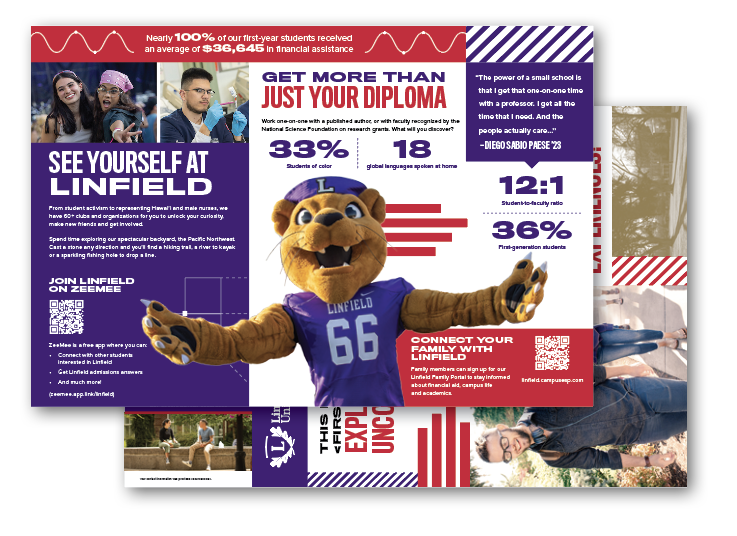
This eye-catching mailer puts Linfield’s bold purple and cardinal branding front and center, using standout stats and a dynamic design to capture attention. Featuring Mack the Wildcat, it reinforces school spirit while guiding students toward their next step—applying with confidence.
American Musical and Dramatic Academy | Dream-Making Applicant Mailer
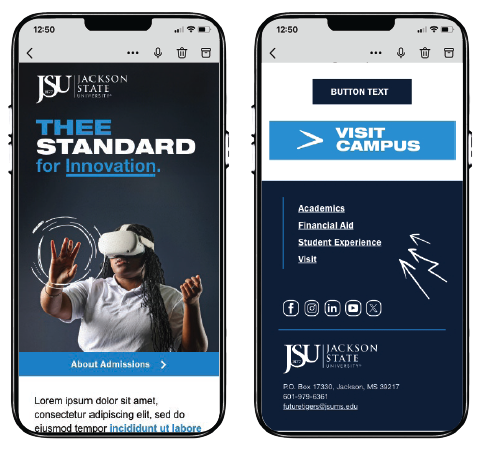
Designed to attract aspiring performers to perform, create, and wow at campuses in New York and Los Angeles, this high-energy mailer steals the spotlight with bold visuals and dynamic performance imagery. Filled with upbeat performance industry lingo, it sets the stage for students to step into their future—and apply.
University of Mount Union | Bold, Strong Instagram Ads
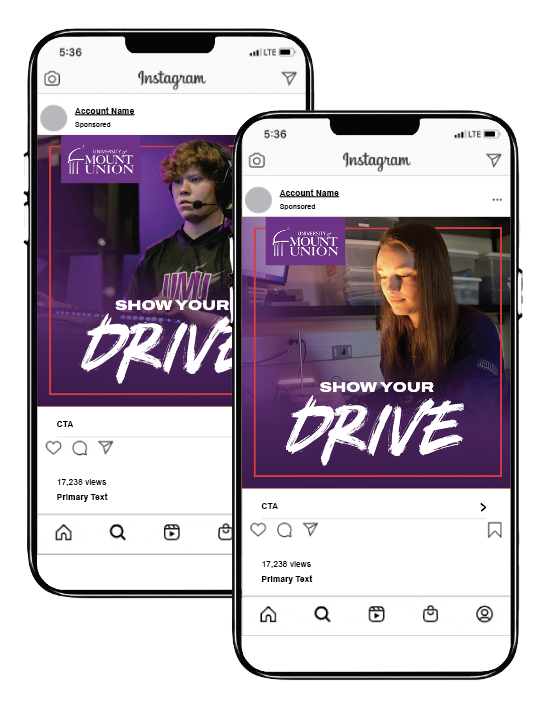
These dynamic search campaign ads put real students front and center, showcasing hands-on learning in action. With bold visuals and empowering copy, the campaign encourages prospects to show up strong, seize opportunities, and own their moment—both in college and beyond.
Rockford University | Feed-Stopping Facebook Ads
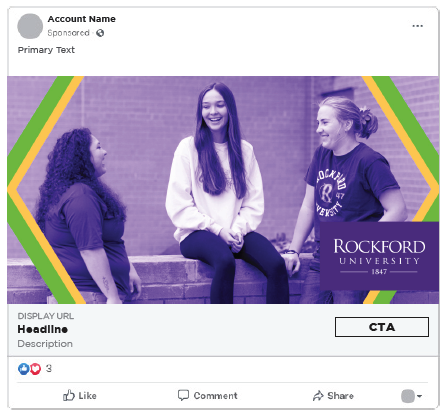
These bright branded ads grab attention alongside the question “RU Ready?”, sparking curiosity about the welcoming environment and numerous opportunities at “RockU.” The campaign is designed to stand out in feeds and aims to inspire students to see themselves on campus and take the next step toward getting there.
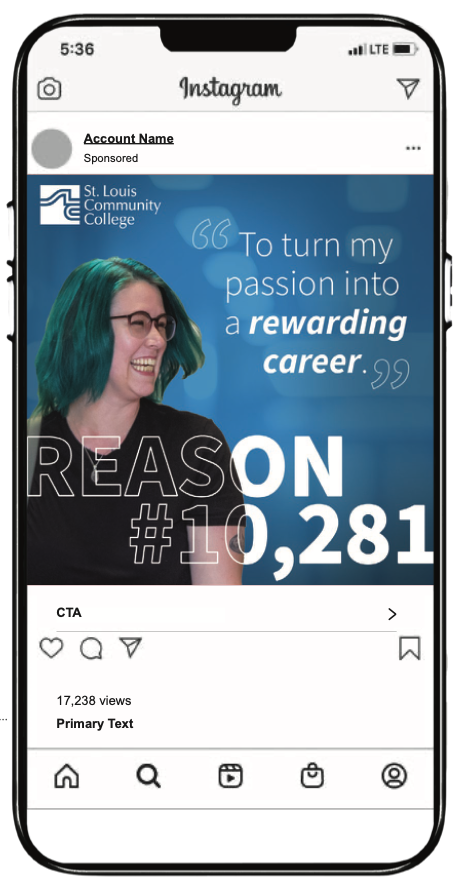
Featuring proud, hopeful, and joyful students, this campaign highlights reasons students choose STLCC to pursue their dreams. The result? Authentic, inspiring ads that encourage prospects to find their reason at STLCC.
Jackson State University | THEE Standard for Search Campaigns

Inspired by Jackson State University’s iconic fight song, this email campaign set the tone with bold headers inviting prospects to learn more about THEE standard for research, academics, innovation, and success. Playful illustrations drawn over dynamic student portraits bring energy and spirit to every email, reinforcing why JSU is THEE place to be.
University of Washington Bothell | Find Your Fit Facebook Ads
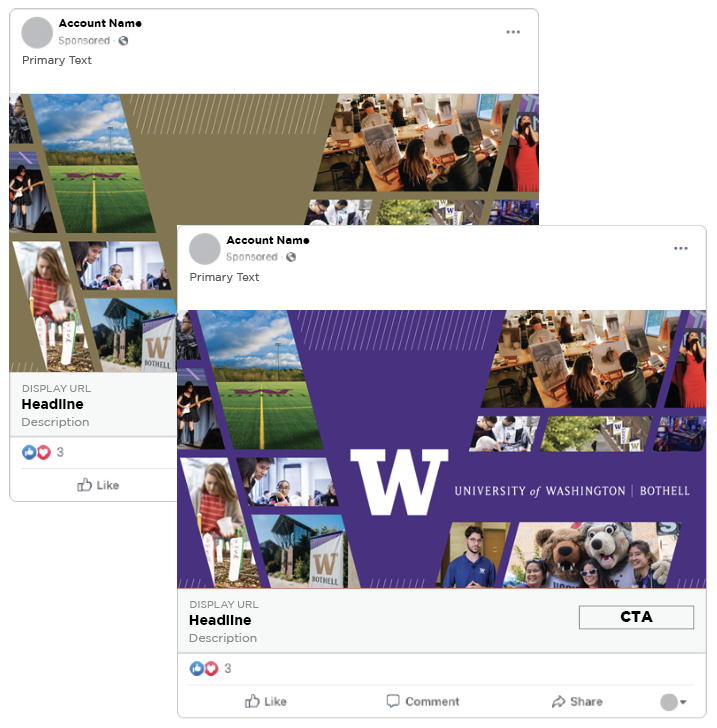
This dynamic ad brings exciting campus life to the forefront, featuring lively action shots shaped into a bold “W.” Paired with inviting copy, it highlights the University of Washington Bothell’s close-knit community where students find big opportunities, exciting challenges, and lifelong friends.
Lamar University | Parent Postcard
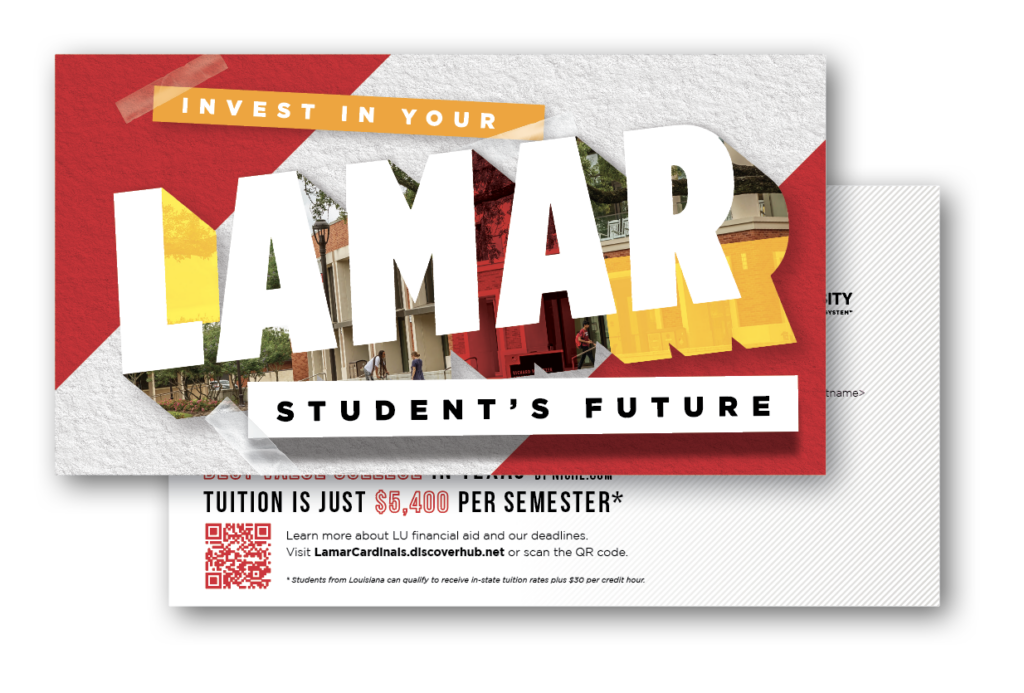
This gold award-winning postcard spoke directly to parents, highlighting the $20+ million in aid and low tuition that make Lamar University the best-value college in Texas. A clear, compelling message reassures families that a smart investment today means big opportunities for their student’s future.
University of Central Florida | Universe of Opportunity Email Series
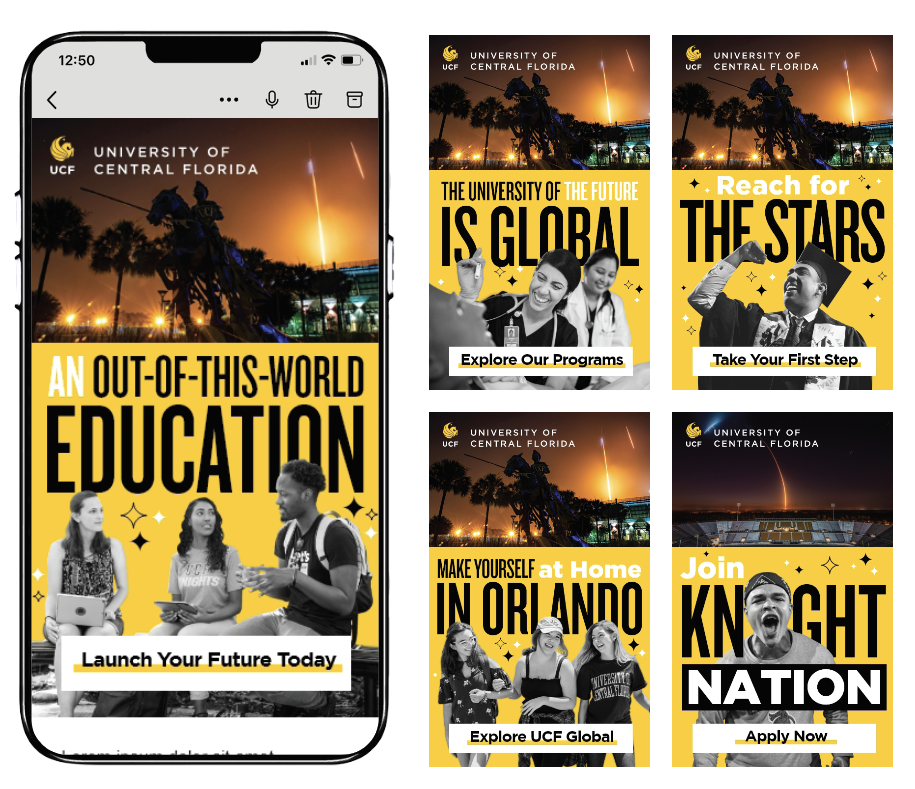
With a prime location between NASA, the Space Coast, and Orlando’s endless experiences, UCF Global offers a launchpad for limitless possibilities. This inquiry-to-application email flow features stunning nightscape imagery and star-inspired design elements reinforcing the university’s spirit of exploration and innovation.
Create your own winning connections with future students
Want to turn your marketing into an award-worthy success? RNL’s creative team brings strategic insight, compelling storytelling, and a track record of 100+ awards in five years to every campaign. Whether you’re engaging undergraduate, graduate, or online students, we’ll help you stand out and drive results. Let’s talk—schedule a complimentary consultation today.
-

Award-Winning Fundraising Campaigns: RNL and Our Campus Partners Receive Seven Gold Medals
RNL’s award-winning creative team wrote this post, sharing their insights on messaging and design. The team has won more than 100 advertising awards for fundraising campaigns.
Fourteen entries. Fourteen awards. For the 40th Annual Educational Advertising Awards, RNL’s creative fundraising campaigns stood out, with every one of our entries winning in their categories. And half won gold!
Being recognized by the largest educational advertising awards in the country speaks to RNL’s mastery of higher education fundraising best practices, as well as our creative team’s expertise and collaboration with our campus partners: the judges review for “creativity, marketing execution and message impact.” These campus partners range from West to East Coast, from small-but-mighty to multi-campus. The creative and fundraising tactics behind these seven award-winning campaigns are equally wide-ranging:
Bethune-Cookman University: Giving Day Total Fund Raising/Development Campaign
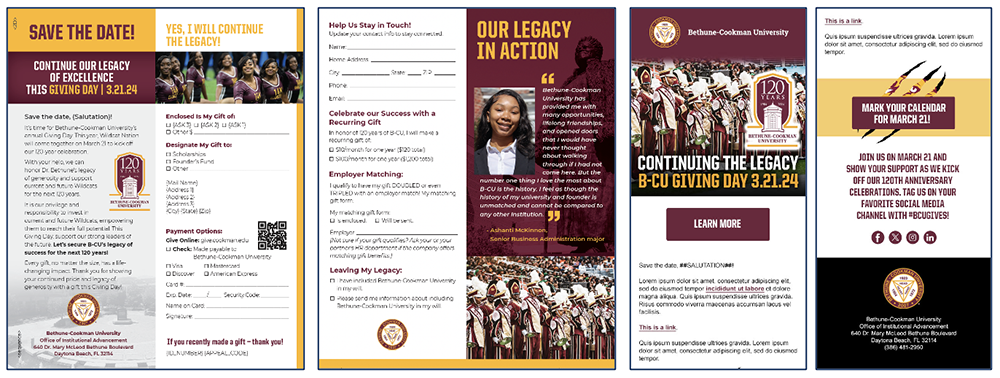
As an extension of Bethune-Cookman University’s advancement team, RNL developed Giving Day mail and emails inviting donors to honor Dr. Mary McLeod Bethune’s legacy. These eye-catching creative components showcased B-CU’s dynamic 120-year brand and emphasized the history of proud investments in Wildcat Nation.
Bennett College: CYE Total Fund Raising/Development Campaign
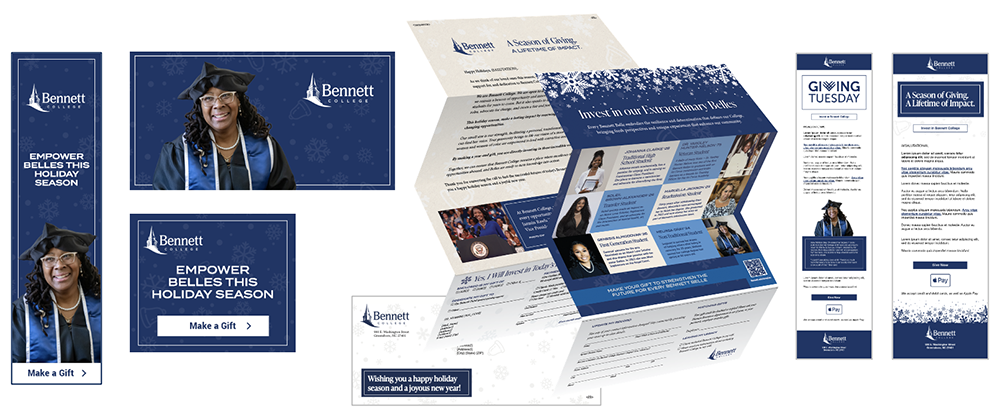
Bennett College serves a broad variety of students, the diversity of which was highlighted in this calendar year-end campaign across mail, email and digital ads. The appeal warmly celebrated Bennett’s donors and alumnae to cultivate connection, while communicating donor impact by demonstrating how their investment in today’s Bennett Belles creates a more equitable future.
Commonwealth University of Pennsylvania: End of Year Total Fund Raising/Development Campaign
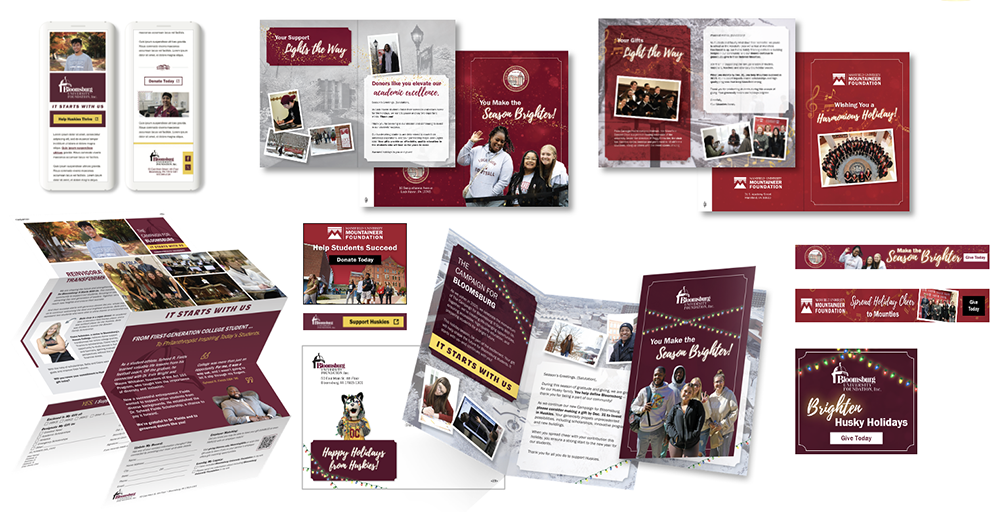
In RNL’s first year of partnering with Commonwealth University Foundation to solicit funds for three campuses—Bloomsburg, Lock Haven and Mansfield—RNL honed in on what makes each campus unique. For the Fall and Calendar Year-End appeals, our investigative writer identified feature stories to resonate with each unique audience while advancing each campus’s priority focus. Our design director created seasonal pieces, including holiday cards worthy of display and GivingTuesday 2024 designs with branding balanced between the campus and the global day of philanthropy.
Linfield University: Homecoming Special Event Campaign

In our third year of fundraising work with Linfield University, RNL helped develop the first Homecoming appeal of our partnership. Appealing to a 50-year reunion alumni segment, a vintage background texture and historic mascot photo inserted nostalgia. Our writer developed copy in the voice of Mack the Wildcat, and our designer created Mack’s signature from scratch, riding the energy of Homecoming to invite alumni support in a fun, engaging way.
Wittenberg University: Calendar Year End Total Digital Marketing Program

The holidays are the most active time for fundraising, and RNL’s emails and digital ads for Wittenberg University pierced through the noise of the season. Leveraging Witt’s primary red and secondary teal colors, the campaign presents a strong, immediately recognizable brand while calling to mind Ohio winters with graphics and background photos from RNL’s Adobe stock account, expanding on the available assets and adding depth, texture and oodles of visual interest.
West Virginia University: Donor Renewal Total Fund Raising/Development Campaign
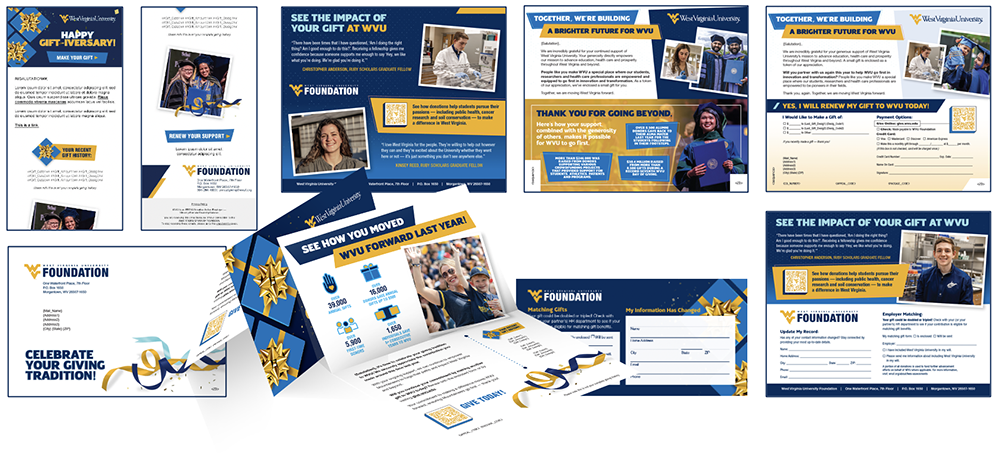
Donors have been clear: Knowing how their generosity makes an impact increases their likelihood to continue investing in an institution. That’s exactly what these pieces did for West Virginia University’s donors. Through a mix of visually appealing quotes, facts and links to video stories, the WVU community saw how important their contribution is—and as a token of gratitude and an investment in retention, they received a window cling acknowledging their donor status for that year, which RNL has created with WVU annually since 2020.
West Virginia University: FYE Direct Mail Appeal
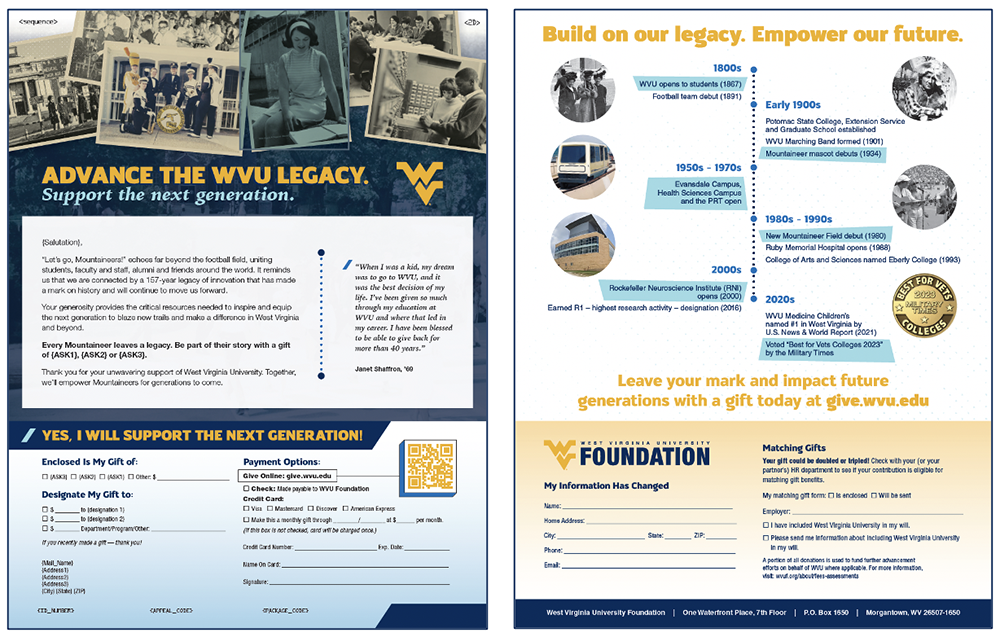
During a time of transition, West Virginia University’s fiscal year end letter showcased how the university’s legacy set the stage for the future. With gradients and strategic placements, the RNL designer used bold brand colors to aesthetically balance the black-and-white photos and a timeline of historical milestones. With a broad audience spanning education, health care and community programs, the language and layout inclusively touches on a variety of key points to resonate with all.
Ready for your award-winning fundraising campaign?
RNL creates world-class fundraising campaigns for colleges, universities, healthcare institutions, and nonprofits. Find out how you can benefit from our award-winning creative, insightful analytics, and unparalleled fundraising expertise. Ask for a complimentary consultation.
-

Your alumni magazine is a source of marketing gold
In a time of skyrocketing paper and postage costs, alumni magazines are paradoxically enjoying a renaissance. After cutting back—or cutting down—print issues during the pandemic, many institutions are now pushing for expanded page counts, more copies, better photography, multimedia extras and more institutional support.
Why?
Because audiences appreciate the thought-provoking content and the tangible, premium reminder of the enduring connection with their alma mater. In a 2024 CASE readership survey, 68 percent of TCU Magazine’s readers reported spending 30 minutes or more with every issue. Almost half reported that the magazine was a go-to source for continuing education.
Journalists are pouring their passion and experience into institutional magazines because higher education shines glimmers of hope into an increasingly dark world. They highlight purpose-driven students who will tackle the problems of the future and brilliant faculty whose research is providing innovative solutions to the planet’s most pressing challenges.
Our readership analytics at TCU Magazine have long shown a strong audience appetite for well-researched and carefully written and edited feature stories about forward momentum and its relationship to education. Since 2015, our overall page views have experienced an astounding 1,300 percent growth. That number sounds outlandish, but I can assure you it is accurate.
Our alumni, parents, donors and internal stakeholders are and always have been the primary audiences. But they aren’t the only people who want to know about the students, faculty, staff and initiatives that thrive on our campus. TCU Magazine’s stories are crafted to be relevant far beyond our campus community and long after the initial date of publication.
In 2021, when all the rules were being rewritten, we proposed a partnership with our colleagues in marketing. We suggested a trial run of using existing magazine stories as peer marketing material, promoting those features to internet users who live in the proximity of the country’s top 150 colleges and universities. The goal was for other professionals in higher education to learn about TCU beyond our exceptional student experience and athletic success.
TCU’s marketing director agreed that long-form content could run alongside more traditional digital marketing materials. Why not? Serving stories about improving teacher retirement plans; developing free, open-source digital mapping tools; or better understanding mutations in the BRCA gene benefit us and all manner of readers.
Audiences learn something new and interesting about how research is shaping the future, and we achieve our goal of enhancing TCU’s academic reputation.
Win-win.
Together, we built a partnership with a digital marketing agency based in Fort Worth. With their expert guidance, we got a crash course in the differences between Google Display Network and SEM keywords, Demand Gen ad placements, bidding strategies, and the wisdom of narrowing ad placements in social media feeds.
We launched our first joint academic content campaign in April 2021 with a modest investment. The results were promising: In two months, we got the TCU initials in front of more than six million people around the country and enticed 87,000 of those people to click on the ad and come to the website to read the story.
Best of all, these were what we refer to as quality clicks, because the average reader spent almost two minutes on one of our stories, far above the internet’s long-form content average of less than 40 seconds. That small trial convinced our divisional leaders that magazine material could be marketing gold.
We didn’t need to reinvent the wheel or invest in outside development of marketing-specific content because we had a treasure trove already flowing from a steady creative stream inside our office.
We expanded the efforts in 2022, sharing new stories with 10.5 million pairs of eyes and bringing 116,000 more people to our site to learn about TCU research. That year, we got an email from Puerto Rico about French professor Benjamin Ireland’s research reuniting families torn apart during forced internment during World War II. “I am not sure why Facebook ‘promoted’ your article to me this morning,” the effusive author shared, “but something made me click to read more.”
We’ve continued to grow these campaigns. Though our mission at the magazine is and always will be to serve the TCU community first, we now factor in whether a proposed story might have a broader impact or might help us tell a more expansive tale about how the type of ethical leadership that flourishes here and makes the world a better place.
My opinion is that these campaigns have worked because they’re a perfect merger of marketing and communication. We’re doing what magazine writers and editors have always done—telling authentic stories about real people doing purpose-driven work.
What’s not to like?


